Sociological Perspectives of Health and Illness: An Analysis
VerifiedAdded on 2023/06/08
|7
|2233
|228
Essay
AI Summary
This essay delves into the sociological perspectives on health and illness, contrasting them with the biomedical model. It begins by introducing sociology and its relevance to health practitioners, emphasizing the role of sociological perspectives in understanding health determinants. The essay then outlines the biomedical model, highlighting its focus on scientific and biological aspects of health, its significance in clinical practice, and its limitations in addressing social determinants. Subsequently, it explores two key sociological perspectives: the functionalist perspective, which views illnesses as disruptions to societal functions, and the conflict approach, which emphasizes social inequalities in health and healthcare access. The essay provides detailed arguments and critiques from both perspectives, illustrating their differing views on the causes and treatment of illnesses. Finally, it concludes by comparing the biomedical and sociological models, emphasizing the importance of both in healthcare settings and suggesting how media platforms can be used to educate people on various sociological perspectives of health to make informed decisions when seeking healthcare services, concluding that medical practitioners base their profession on the biomedical model.
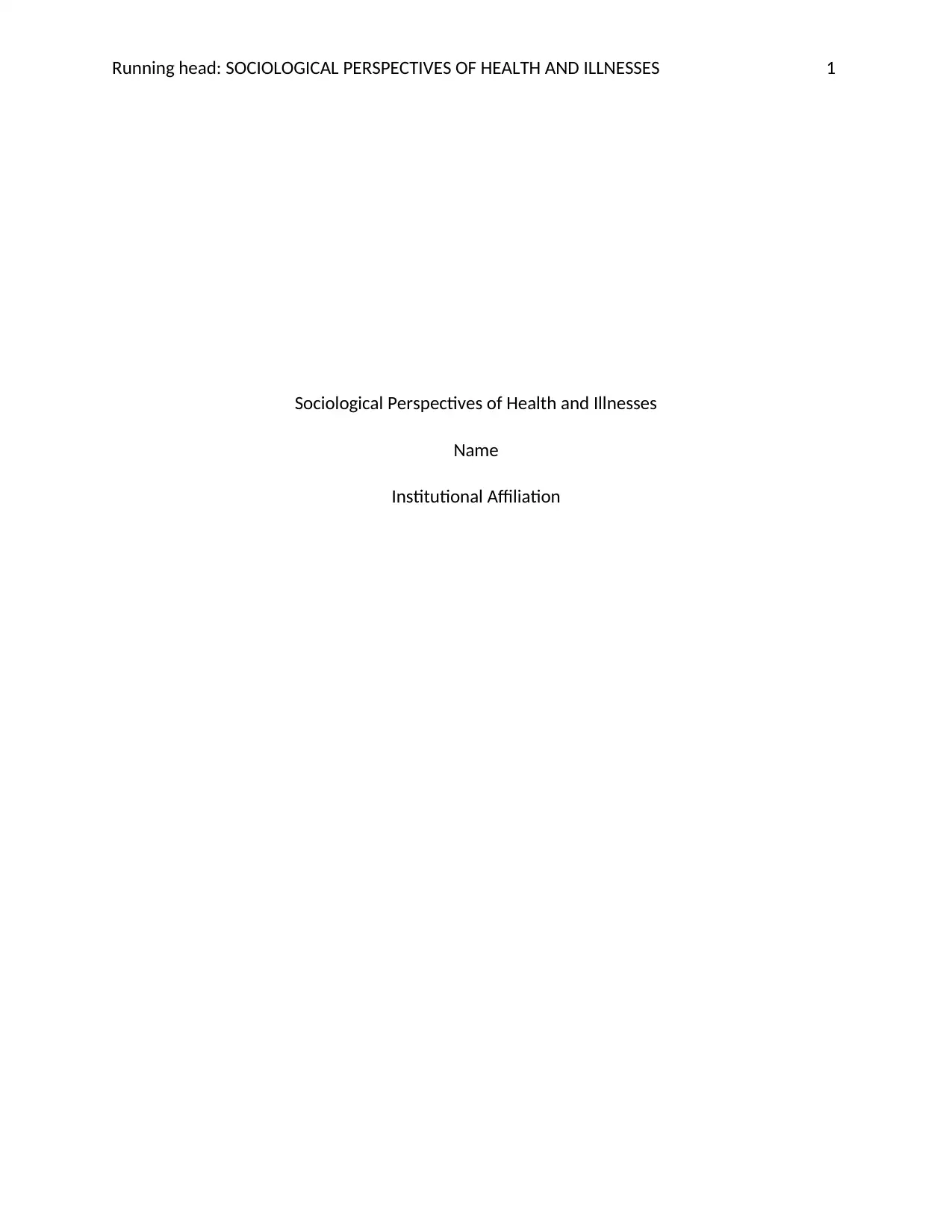
Running head: SOCIOLOGICAL PERSPECTIVES OF HEALTH AND ILLNESSES 1
Sociological Perspectives of Health and Illnesses
Name
Institutional Affiliation
Sociological Perspectives of Health and Illnesses
Name
Institutional Affiliation
Paraphrase This Document
Need a fresh take? Get an instant paraphrase of this document with our AI Paraphraser
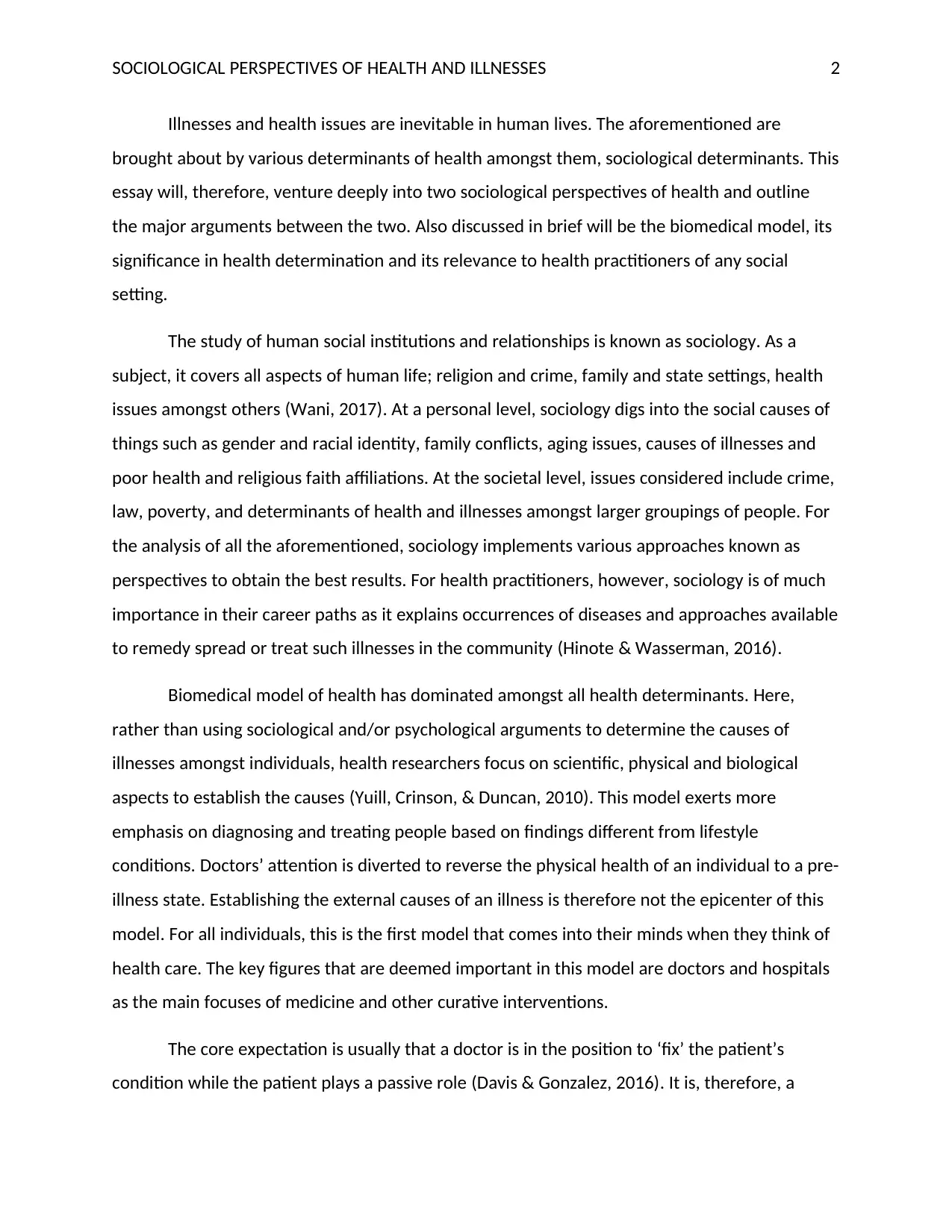
SOCIOLOGICAL PERSPECTIVES OF HEALTH AND ILLNESSES 2
Illnesses and health issues are inevitable in human lives. The aforementioned are
brought about by various determinants of health amongst them, sociological determinants. This
essay will, therefore, venture deeply into two sociological perspectives of health and outline
the major arguments between the two. Also discussed in brief will be the biomedical model, its
significance in health determination and its relevance to health practitioners of any social
setting.
The study of human social institutions and relationships is known as sociology. As a
subject, it covers all aspects of human life; religion and crime, family and state settings, health
issues amongst others (Wani, 2017). At a personal level, sociology digs into the social causes of
things such as gender and racial identity, family conflicts, aging issues, causes of illnesses and
poor health and religious faith affiliations. At the societal level, issues considered include crime,
law, poverty, and determinants of health and illnesses amongst larger groupings of people. For
the analysis of all the aforementioned, sociology implements various approaches known as
perspectives to obtain the best results. For health practitioners, however, sociology is of much
importance in their career paths as it explains occurrences of diseases and approaches available
to remedy spread or treat such illnesses in the community (Hinote & Wasserman, 2016).
Biomedical model of health has dominated amongst all health determinants. Here,
rather than using sociological and/or psychological arguments to determine the causes of
illnesses amongst individuals, health researchers focus on scientific, physical and biological
aspects to establish the causes (Yuill, Crinson, & Duncan, 2010). This model exerts more
emphasis on diagnosing and treating people based on findings different from lifestyle
conditions. Doctors’ attention is diverted to reverse the physical health of an individual to a pre-
illness state. Establishing the external causes of an illness is therefore not the epicenter of this
model. For all individuals, this is the first model that comes into their minds when they think of
health care. The key figures that are deemed important in this model are doctors and hospitals
as the main focuses of medicine and other curative interventions.
The core expectation is usually that a doctor is in the position to ‘fix’ the patient’s
condition while the patient plays a passive role (Davis & Gonzalez, 2016). It is, therefore, a
Illnesses and health issues are inevitable in human lives. The aforementioned are
brought about by various determinants of health amongst them, sociological determinants. This
essay will, therefore, venture deeply into two sociological perspectives of health and outline
the major arguments between the two. Also discussed in brief will be the biomedical model, its
significance in health determination and its relevance to health practitioners of any social
setting.
The study of human social institutions and relationships is known as sociology. As a
subject, it covers all aspects of human life; religion and crime, family and state settings, health
issues amongst others (Wani, 2017). At a personal level, sociology digs into the social causes of
things such as gender and racial identity, family conflicts, aging issues, causes of illnesses and
poor health and religious faith affiliations. At the societal level, issues considered include crime,
law, poverty, and determinants of health and illnesses amongst larger groupings of people. For
the analysis of all the aforementioned, sociology implements various approaches known as
perspectives to obtain the best results. For health practitioners, however, sociology is of much
importance in their career paths as it explains occurrences of diseases and approaches available
to remedy spread or treat such illnesses in the community (Hinote & Wasserman, 2016).
Biomedical model of health has dominated amongst all health determinants. Here,
rather than using sociological and/or psychological arguments to determine the causes of
illnesses amongst individuals, health researchers focus on scientific, physical and biological
aspects to establish the causes (Yuill, Crinson, & Duncan, 2010). This model exerts more
emphasis on diagnosing and treating people based on findings different from lifestyle
conditions. Doctors’ attention is diverted to reverse the physical health of an individual to a pre-
illness state. Establishing the external causes of an illness is therefore not the epicenter of this
model. For all individuals, this is the first model that comes into their minds when they think of
health care. The key figures that are deemed important in this model are doctors and hospitals
as the main focuses of medicine and other curative interventions.
The core expectation is usually that a doctor is in the position to ‘fix’ the patient’s
condition while the patient plays a passive role (Davis & Gonzalez, 2016). It is, therefore, a
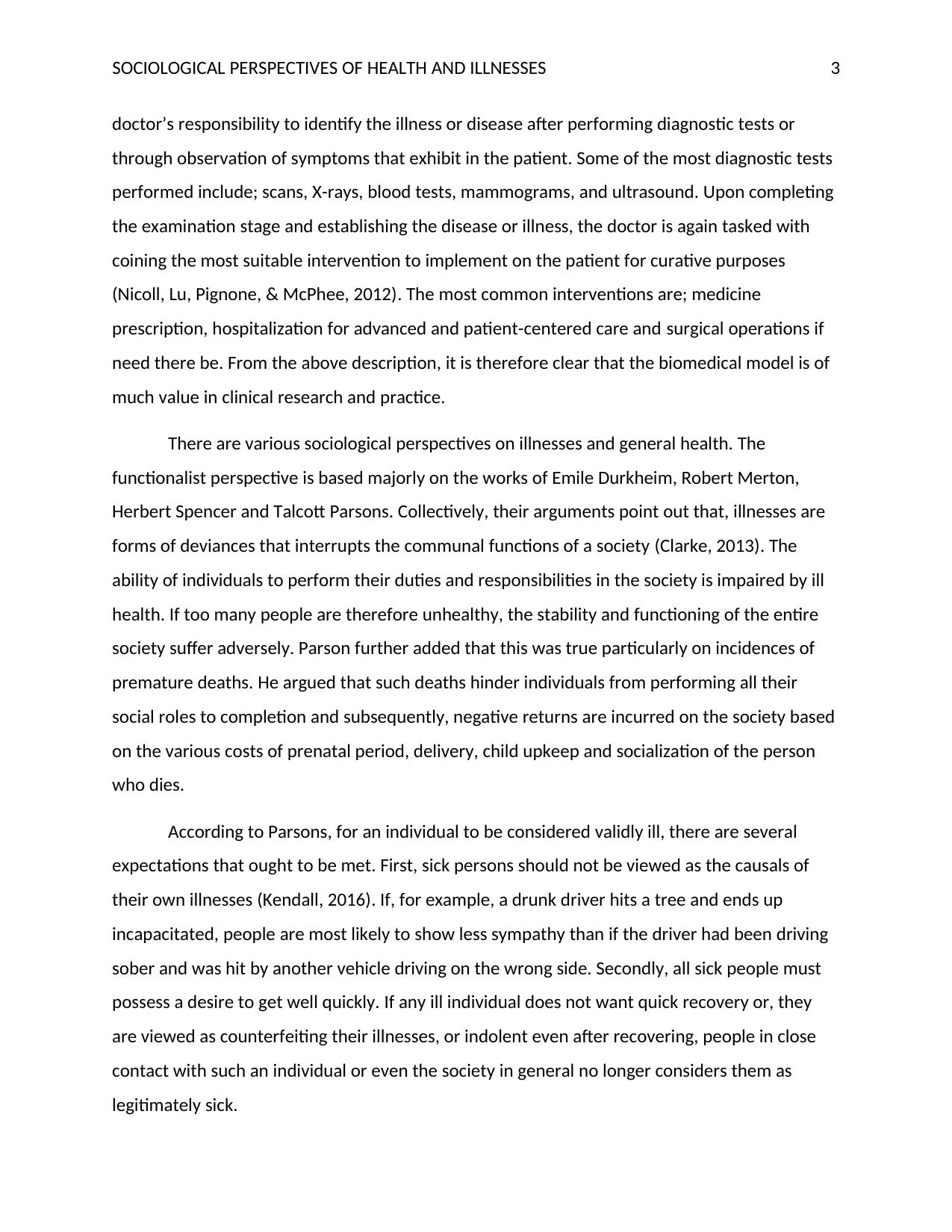
SOCIOLOGICAL PERSPECTIVES OF HEALTH AND ILLNESSES 3
doctor’s responsibility to identify the illness or disease after performing diagnostic tests or
through observation of symptoms that exhibit in the patient. Some of the most diagnostic tests
performed include; scans, X-rays, blood tests, mammograms, and ultrasound. Upon completing
the examination stage and establishing the disease or illness, the doctor is again tasked with
coining the most suitable intervention to implement on the patient for curative purposes
(Nicoll, Lu, Pignone, & McPhee, 2012). The most common interventions are; medicine
prescription, hospitalization for advanced and patient-centered care and surgical operations if
need there be. From the above description, it is therefore clear that the biomedical model is of
much value in clinical research and practice.
There are various sociological perspectives on illnesses and general health. The
functionalist perspective is based majorly on the works of Emile Durkheim, Robert Merton,
Herbert Spencer and Talcott Parsons. Collectively, their arguments point out that, illnesses are
forms of deviances that interrupts the communal functions of a society (Clarke, 2013). The
ability of individuals to perform their duties and responsibilities in the society is impaired by ill
health. If too many people are therefore unhealthy, the stability and functioning of the entire
society suffer adversely. Parson further added that this was true particularly on incidences of
premature deaths. He argued that such deaths hinder individuals from performing all their
social roles to completion and subsequently, negative returns are incurred on the society based
on the various costs of prenatal period, delivery, child upkeep and socialization of the person
who dies.
According to Parsons, for an individual to be considered validly ill, there are several
expectations that ought to be met. First, sick persons should not be viewed as the causals of
their own illnesses (Kendall, 2016). If, for example, a drunk driver hits a tree and ends up
incapacitated, people are most likely to show less sympathy than if the driver had been driving
sober and was hit by another vehicle driving on the wrong side. Secondly, all sick people must
possess a desire to get well quickly. If any ill individual does not want quick recovery or, they
are viewed as counterfeiting their illnesses, or indolent even after recovering, people in close
contact with such an individual or even the society in general no longer considers them as
legitimately sick.
doctor’s responsibility to identify the illness or disease after performing diagnostic tests or
through observation of symptoms that exhibit in the patient. Some of the most diagnostic tests
performed include; scans, X-rays, blood tests, mammograms, and ultrasound. Upon completing
the examination stage and establishing the disease or illness, the doctor is again tasked with
coining the most suitable intervention to implement on the patient for curative purposes
(Nicoll, Lu, Pignone, & McPhee, 2012). The most common interventions are; medicine
prescription, hospitalization for advanced and patient-centered care and surgical operations if
need there be. From the above description, it is therefore clear that the biomedical model is of
much value in clinical research and practice.
There are various sociological perspectives on illnesses and general health. The
functionalist perspective is based majorly on the works of Emile Durkheim, Robert Merton,
Herbert Spencer and Talcott Parsons. Collectively, their arguments point out that, illnesses are
forms of deviances that interrupts the communal functions of a society (Clarke, 2013). The
ability of individuals to perform their duties and responsibilities in the society is impaired by ill
health. If too many people are therefore unhealthy, the stability and functioning of the entire
society suffer adversely. Parson further added that this was true particularly on incidences of
premature deaths. He argued that such deaths hinder individuals from performing all their
social roles to completion and subsequently, negative returns are incurred on the society based
on the various costs of prenatal period, delivery, child upkeep and socialization of the person
who dies.
According to Parsons, for an individual to be considered validly ill, there are several
expectations that ought to be met. First, sick persons should not be viewed as the causals of
their own illnesses (Kendall, 2016). If, for example, a drunk driver hits a tree and ends up
incapacitated, people are most likely to show less sympathy than if the driver had been driving
sober and was hit by another vehicle driving on the wrong side. Secondly, all sick people must
possess a desire to get well quickly. If any ill individual does not want quick recovery or, they
are viewed as counterfeiting their illnesses, or indolent even after recovering, people in close
contact with such an individual or even the society in general no longer considers them as
legitimately sick.
⊘ This is a preview!⊘
Do you want full access?
Subscribe today to unlock all pages.

Trusted by 1+ million students worldwide
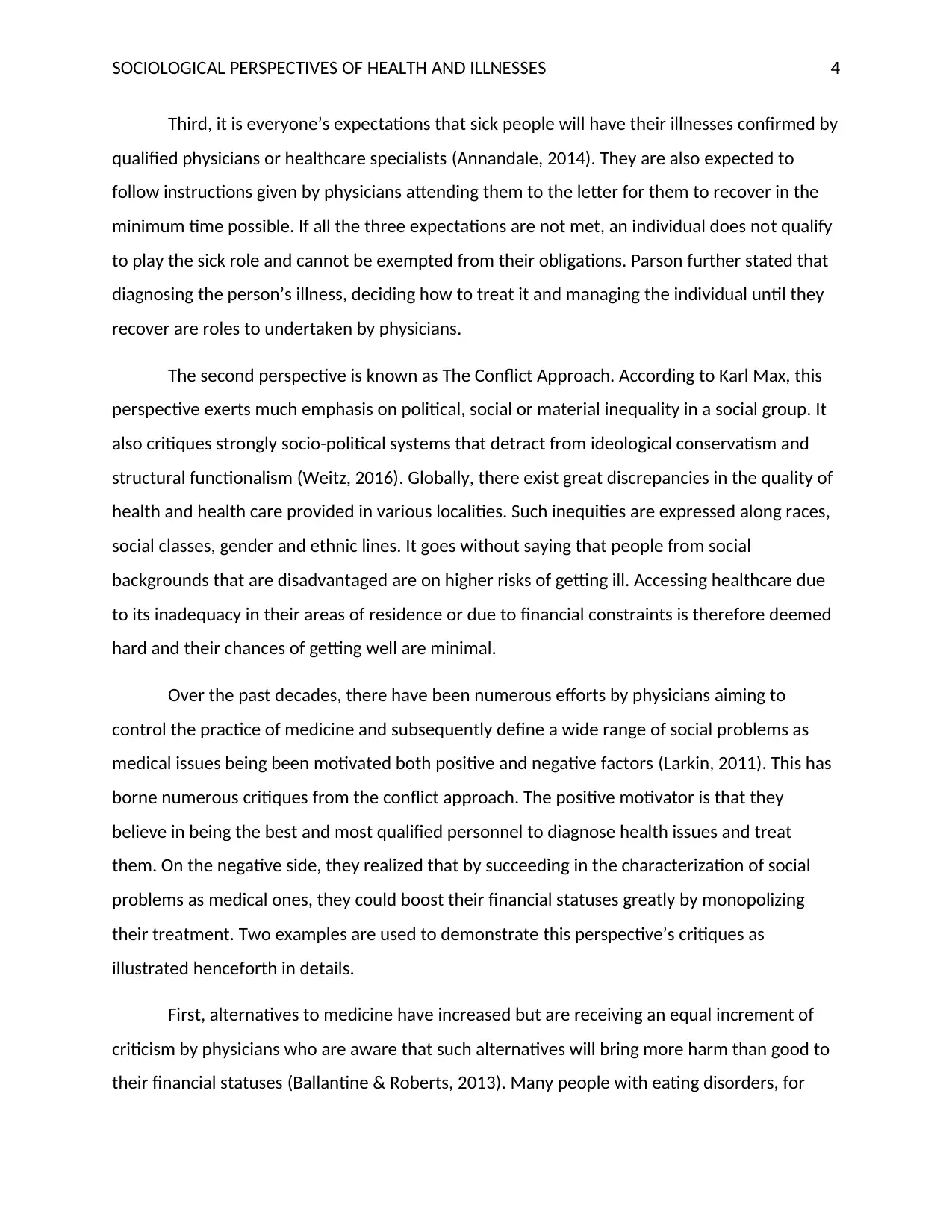
SOCIOLOGICAL PERSPECTIVES OF HEALTH AND ILLNESSES 4
Third, it is everyone’s expectations that sick people will have their illnesses confirmed by
qualified physicians or healthcare specialists (Annandale, 2014). They are also expected to
follow instructions given by physicians attending them to the letter for them to recover in the
minimum time possible. If all the three expectations are not met, an individual does not qualify
to play the sick role and cannot be exempted from their obligations. Parson further stated that
diagnosing the person’s illness, deciding how to treat it and managing the individual until they
recover are roles to undertaken by physicians.
The second perspective is known as The Conflict Approach. According to Karl Max, this
perspective exerts much emphasis on political, social or material inequality in a social group. It
also critiques strongly socio-political systems that detract from ideological conservatism and
structural functionalism (Weitz, 2016). Globally, there exist great discrepancies in the quality of
health and health care provided in various localities. Such inequities are expressed along races,
social classes, gender and ethnic lines. It goes without saying that people from social
backgrounds that are disadvantaged are on higher risks of getting ill. Accessing healthcare due
to its inadequacy in their areas of residence or due to financial constraints is therefore deemed
hard and their chances of getting well are minimal.
Over the past decades, there have been numerous efforts by physicians aiming to
control the practice of medicine and subsequently define a wide range of social problems as
medical issues being been motivated both positive and negative factors (Larkin, 2011). This has
borne numerous critiques from the conflict approach. The positive motivator is that they
believe in being the best and most qualified personnel to diagnose health issues and treat
them. On the negative side, they realized that by succeeding in the characterization of social
problems as medical ones, they could boost their financial statuses greatly by monopolizing
their treatment. Two examples are used to demonstrate this perspective’s critiques as
illustrated henceforth in details.
First, alternatives to medicine have increased but are receiving an equal increment of
criticism by physicians who are aware that such alternatives will bring more harm than good to
their financial statuses (Ballantine & Roberts, 2013). Many people with eating disorders, for
Third, it is everyone’s expectations that sick people will have their illnesses confirmed by
qualified physicians or healthcare specialists (Annandale, 2014). They are also expected to
follow instructions given by physicians attending them to the letter for them to recover in the
minimum time possible. If all the three expectations are not met, an individual does not qualify
to play the sick role and cannot be exempted from their obligations. Parson further stated that
diagnosing the person’s illness, deciding how to treat it and managing the individual until they
recover are roles to undertaken by physicians.
The second perspective is known as The Conflict Approach. According to Karl Max, this
perspective exerts much emphasis on political, social or material inequality in a social group. It
also critiques strongly socio-political systems that detract from ideological conservatism and
structural functionalism (Weitz, 2016). Globally, there exist great discrepancies in the quality of
health and health care provided in various localities. Such inequities are expressed along races,
social classes, gender and ethnic lines. It goes without saying that people from social
backgrounds that are disadvantaged are on higher risks of getting ill. Accessing healthcare due
to its inadequacy in their areas of residence or due to financial constraints is therefore deemed
hard and their chances of getting well are minimal.
Over the past decades, there have been numerous efforts by physicians aiming to
control the practice of medicine and subsequently define a wide range of social problems as
medical issues being been motivated both positive and negative factors (Larkin, 2011). This has
borne numerous critiques from the conflict approach. The positive motivator is that they
believe in being the best and most qualified personnel to diagnose health issues and treat
them. On the negative side, they realized that by succeeding in the characterization of social
problems as medical ones, they could boost their financial statuses greatly by monopolizing
their treatment. Two examples are used to demonstrate this perspective’s critiques as
illustrated henceforth in details.
First, alternatives to medicine have increased but are receiving an equal increment of
criticism by physicians who are aware that such alternatives will bring more harm than good to
their financial statuses (Ballantine & Roberts, 2013). Many people with eating disorders, for
Paraphrase This Document
Need a fresh take? Get an instant paraphrase of this document with our AI Paraphraser
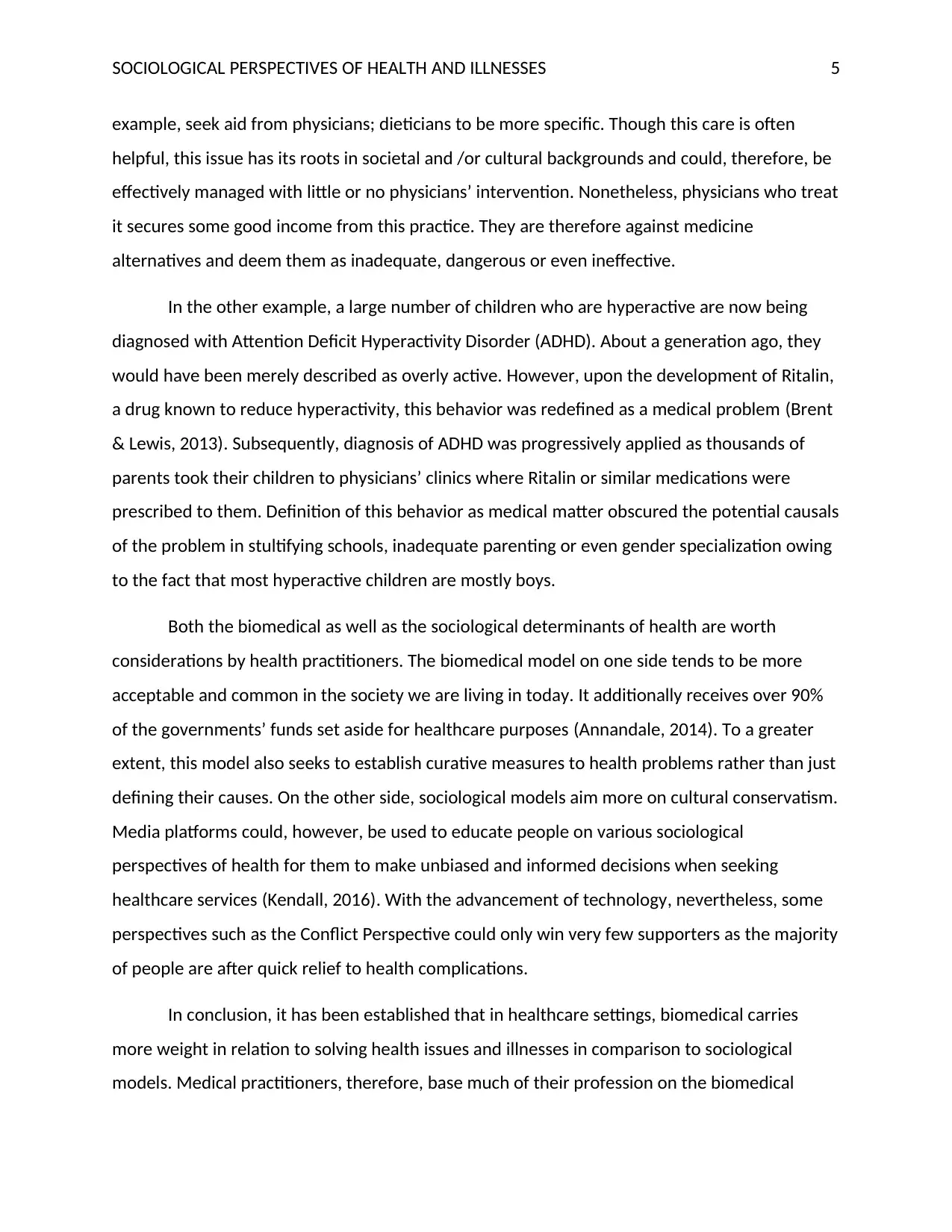
SOCIOLOGICAL PERSPECTIVES OF HEALTH AND ILLNESSES 5
example, seek aid from physicians; dieticians to be more specific. Though this care is often
helpful, this issue has its roots in societal and /or cultural backgrounds and could, therefore, be
effectively managed with little or no physicians’ intervention. Nonetheless, physicians who treat
it secures some good income from this practice. They are therefore against medicine
alternatives and deem them as inadequate, dangerous or even ineffective.
In the other example, a large number of children who are hyperactive are now being
diagnosed with Attention Deficit Hyperactivity Disorder (ADHD). About a generation ago, they
would have been merely described as overly active. However, upon the development of Ritalin,
a drug known to reduce hyperactivity, this behavior was redefined as a medical problem (Brent
& Lewis, 2013). Subsequently, diagnosis of ADHD was progressively applied as thousands of
parents took their children to physicians’ clinics where Ritalin or similar medications were
prescribed to them. Definition of this behavior as medical matter obscured the potential causals
of the problem in stultifying schools, inadequate parenting or even gender specialization owing
to the fact that most hyperactive children are mostly boys.
Both the biomedical as well as the sociological determinants of health are worth
considerations by health practitioners. The biomedical model on one side tends to be more
acceptable and common in the society we are living in today. It additionally receives over 90%
of the governments’ funds set aside for healthcare purposes (Annandale, 2014). To a greater
extent, this model also seeks to establish curative measures to health problems rather than just
defining their causes. On the other side, sociological models aim more on cultural conservatism.
Media platforms could, however, be used to educate people on various sociological
perspectives of health for them to make unbiased and informed decisions when seeking
healthcare services (Kendall, 2016). With the advancement of technology, nevertheless, some
perspectives such as the Conflict Perspective could only win very few supporters as the majority
of people are after quick relief to health complications.
In conclusion, it has been established that in healthcare settings, biomedical carries
more weight in relation to solving health issues and illnesses in comparison to sociological
models. Medical practitioners, therefore, base much of their profession on the biomedical
example, seek aid from physicians; dieticians to be more specific. Though this care is often
helpful, this issue has its roots in societal and /or cultural backgrounds and could, therefore, be
effectively managed with little or no physicians’ intervention. Nonetheless, physicians who treat
it secures some good income from this practice. They are therefore against medicine
alternatives and deem them as inadequate, dangerous or even ineffective.
In the other example, a large number of children who are hyperactive are now being
diagnosed with Attention Deficit Hyperactivity Disorder (ADHD). About a generation ago, they
would have been merely described as overly active. However, upon the development of Ritalin,
a drug known to reduce hyperactivity, this behavior was redefined as a medical problem (Brent
& Lewis, 2013). Subsequently, diagnosis of ADHD was progressively applied as thousands of
parents took their children to physicians’ clinics where Ritalin or similar medications were
prescribed to them. Definition of this behavior as medical matter obscured the potential causals
of the problem in stultifying schools, inadequate parenting or even gender specialization owing
to the fact that most hyperactive children are mostly boys.
Both the biomedical as well as the sociological determinants of health are worth
considerations by health practitioners. The biomedical model on one side tends to be more
acceptable and common in the society we are living in today. It additionally receives over 90%
of the governments’ funds set aside for healthcare purposes (Annandale, 2014). To a greater
extent, this model also seeks to establish curative measures to health problems rather than just
defining their causes. On the other side, sociological models aim more on cultural conservatism.
Media platforms could, however, be used to educate people on various sociological
perspectives of health for them to make unbiased and informed decisions when seeking
healthcare services (Kendall, 2016). With the advancement of technology, nevertheless, some
perspectives such as the Conflict Perspective could only win very few supporters as the majority
of people are after quick relief to health complications.
In conclusion, it has been established that in healthcare settings, biomedical carries
more weight in relation to solving health issues and illnesses in comparison to sociological
models. Medical practitioners, therefore, base much of their profession on the biomedical
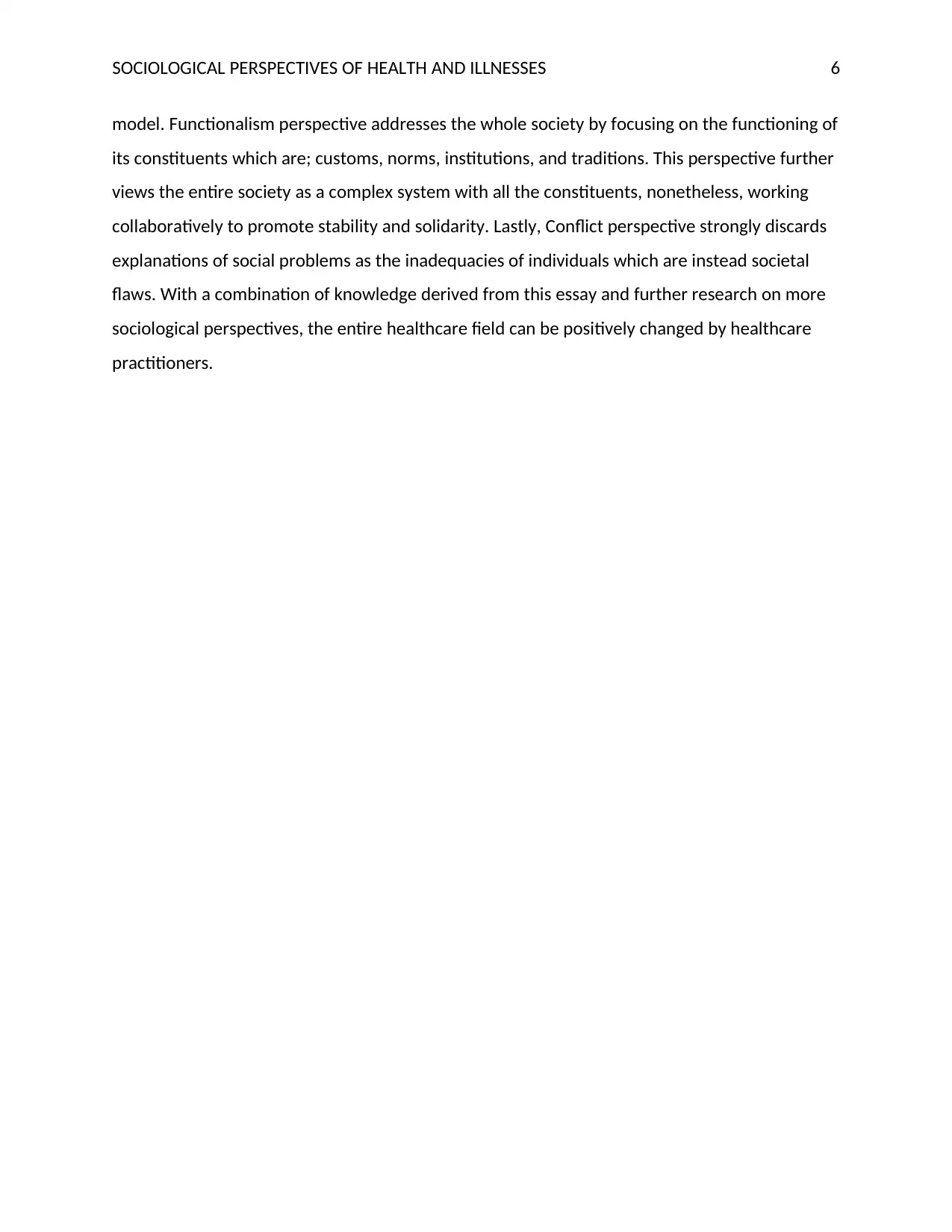
SOCIOLOGICAL PERSPECTIVES OF HEALTH AND ILLNESSES 6
model. Functionalism perspective addresses the whole society by focusing on the functioning of
its constituents which are; customs, norms, institutions, and traditions. This perspective further
views the entire society as a complex system with all the constituents, nonetheless, working
collaboratively to promote stability and solidarity. Lastly, Conflict perspective strongly discards
explanations of social problems as the inadequacies of individuals which are instead societal
flaws. With a combination of knowledge derived from this essay and further research on more
sociological perspectives, the entire healthcare field can be positively changed by healthcare
practitioners.
model. Functionalism perspective addresses the whole society by focusing on the functioning of
its constituents which are; customs, norms, institutions, and traditions. This perspective further
views the entire society as a complex system with all the constituents, nonetheless, working
collaboratively to promote stability and solidarity. Lastly, Conflict perspective strongly discards
explanations of social problems as the inadequacies of individuals which are instead societal
flaws. With a combination of knowledge derived from this essay and further research on more
sociological perspectives, the entire healthcare field can be positively changed by healthcare
practitioners.
⊘ This is a preview!⊘
Do you want full access?
Subscribe today to unlock all pages.

Trusted by 1+ million students worldwide
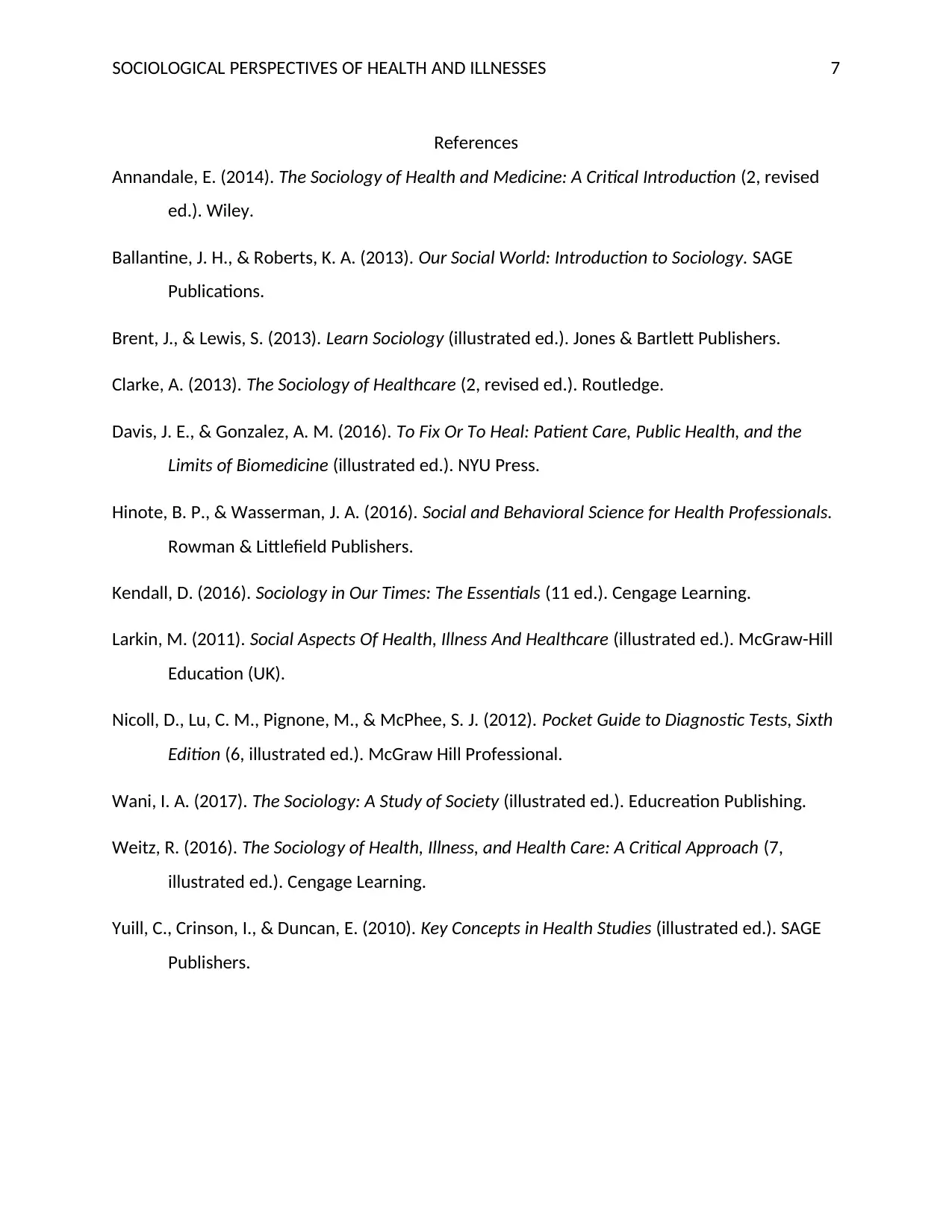
SOCIOLOGICAL PERSPECTIVES OF HEALTH AND ILLNESSES 7
References
Annandale, E. (2014). The Sociology of Health and Medicine: A Critical Introduction (2, revised
ed.). Wiley.
Ballantine, J. H., & Roberts, K. A. (2013). Our Social World: Introduction to Sociology. SAGE
Publications.
Brent, J., & Lewis, S. (2013). Learn Sociology (illustrated ed.). Jones & Bartlett Publishers.
Clarke, A. (2013). The Sociology of Healthcare (2, revised ed.). Routledge.
Davis, J. E., & Gonzalez, A. M. (2016). To Fix Or To Heal: Patient Care, Public Health, and the
Limits of Biomedicine (illustrated ed.). NYU Press.
Hinote, B. P., & Wasserman, J. A. (2016). Social and Behavioral Science for Health Professionals.
Rowman & Littlefield Publishers.
Kendall, D. (2016). Sociology in Our Times: The Essentials (11 ed.). Cengage Learning.
Larkin, M. (2011). Social Aspects Of Health, Illness And Healthcare (illustrated ed.). McGraw-Hill
Education (UK).
Nicoll, D., Lu, C. M., Pignone, M., & McPhee, S. J. (2012). Pocket Guide to Diagnostic Tests, Sixth
Edition (6, illustrated ed.). McGraw Hill Professional.
Wani, I. A. (2017). The Sociology: A Study of Society (illustrated ed.). Educreation Publishing.
Weitz, R. (2016). The Sociology of Health, Illness, and Health Care: A Critical Approach (7,
illustrated ed.). Cengage Learning.
Yuill, C., Crinson, I., & Duncan, E. (2010). Key Concepts in Health Studies (illustrated ed.). SAGE
Publishers.
References
Annandale, E. (2014). The Sociology of Health and Medicine: A Critical Introduction (2, revised
ed.). Wiley.
Ballantine, J. H., & Roberts, K. A. (2013). Our Social World: Introduction to Sociology. SAGE
Publications.
Brent, J., & Lewis, S. (2013). Learn Sociology (illustrated ed.). Jones & Bartlett Publishers.
Clarke, A. (2013). The Sociology of Healthcare (2, revised ed.). Routledge.
Davis, J. E., & Gonzalez, A. M. (2016). To Fix Or To Heal: Patient Care, Public Health, and the
Limits of Biomedicine (illustrated ed.). NYU Press.
Hinote, B. P., & Wasserman, J. A. (2016). Social and Behavioral Science for Health Professionals.
Rowman & Littlefield Publishers.
Kendall, D. (2016). Sociology in Our Times: The Essentials (11 ed.). Cengage Learning.
Larkin, M. (2011). Social Aspects Of Health, Illness And Healthcare (illustrated ed.). McGraw-Hill
Education (UK).
Nicoll, D., Lu, C. M., Pignone, M., & McPhee, S. J. (2012). Pocket Guide to Diagnostic Tests, Sixth
Edition (6, illustrated ed.). McGraw Hill Professional.
Wani, I. A. (2017). The Sociology: A Study of Society (illustrated ed.). Educreation Publishing.
Weitz, R. (2016). The Sociology of Health, Illness, and Health Care: A Critical Approach (7,
illustrated ed.). Cengage Learning.
Yuill, C., Crinson, I., & Duncan, E. (2010). Key Concepts in Health Studies (illustrated ed.). SAGE
Publishers.
1 out of 7
Related Documents
Your All-in-One AI-Powered Toolkit for Academic Success.
+13062052269
info@desklib.com
Available 24*7 on WhatsApp / Email
![[object Object]](/_next/static/media/star-bottom.7253800d.svg)
Unlock your academic potential
Copyright © 2020–2025 A2Z Services. All Rights Reserved. Developed and managed by ZUCOL.





